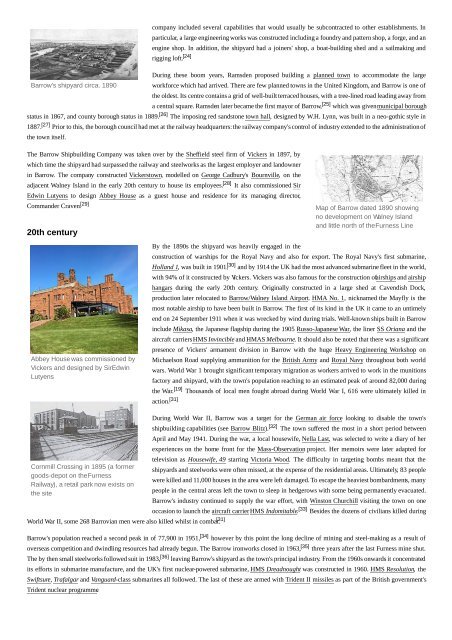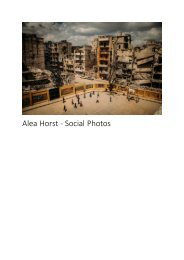pdf-zusammengefasst
Create successful ePaper yourself
Turn your PDF publications into a flip-book with our unique Google optimized e-Paper software.
Barrow's shipyard circa. 1890<br />
company included several capabilities that would usually be subcontracted to other establishments. In<br />
particular, a large engineering works was constructed including a foundry and pattern shop, a forge, and an<br />
engine shop. In addition, the shipyard had a joiners' shop, a boat-building shed and a sailmaking and<br />
rigging loft. [24]<br />
During these boom years, Ramsden proposed building a planned town to accommodate the large<br />
workforce which had arrived. There are few planned towns in the United Kingdom, and Barrow is one of<br />
the oldest. Its centre contains a grid of well-built terraced houses, with a tree-lined road leading away from<br />
a central square. Ramsden later became the first mayor of Barrow, [25] which was given municipal borough<br />
status in 1867, and county borough status in 1889. [26] The imposing red sandstone town hall, designed by W.H. Lynn, was built in a neo-gothic style in<br />
1887. [27] Prior to this, the borough council had met at the railway headquarters: the railway company's control of industry extended to the administration of<br />
the town itself.<br />
The Barrow Shipbuilding Company was taken over by the Sheffield steel firm of Vickers in 1897, by<br />
which time the shipyard had surpassed the railway and steelworks as the largest employer and landowner<br />
in Barrow. The company constructed Vickerstown, modelled on George Cadbury's Bournville, on the<br />
adjacent Walney Island in the early 20th century to house its employees. [28] It also commissioned Sir<br />
Edwin Lutyens to design Abbey House as a guest house and residence for its managing director,<br />
Commander Craven. [29]<br />
20th century<br />
Map of Barrow dated 1890 showing<br />
no development on Walney Island<br />
and little north of the Furness Line<br />
Abbey House was commissioned by<br />
Vickers and designed by Sir Edwin<br />
Lutyens<br />
By the 1890s the shipyard was heavily engaged in the<br />
construction of warships for the Royal Navy and also for export. The Royal Navy's first submarine,<br />
Holland 1, was built in 1901, [30] and by 1914 the UK had the most advanced submarine fleet in the world,<br />
with 94% of it constructed by Vickers. Vickers was also famous for the construction of airships and airship<br />
hangars during the early 20th century. Originally constructed in a large shed at Cavendish Dock,<br />
production later relocated to Barrow/Walney Island Airport. HMA No. 1, nicknamed the Mayfly is the<br />
most notable airship to have been built in Barrow. The first of its kind in the UK it came to an untimely<br />
end on 24 September 1911 when it was wrecked by wind during trials. Well-known ships built in Barrow<br />
include Mikasa, the Japanese flagship during the 1905 Russo-Japanese War, the liner SS Oriana and the<br />
aircraft carriers HMS Invincible and HMAS Melbourne. It should also be noted that there was a significant<br />
presence of Vickers' armament division in Barrow with the huge Heavy Engineering Workshop on<br />
Michaelson Road supplying ammunition for the British Army and Royal Navy throughout both world<br />
wars. World War 1 brought significant temporary migration as workers arrived to work in the munitions<br />
factory and shipyard, with the town's population reaching to an estimated peak of around 82,000 during<br />
the War. [19] Thousands of local men fought abroad during World War I, 616 were ultimately killed in<br />
action. [31]<br />
Cornmill Crossing in 1895 (a former<br />
goods-depot on the Furness<br />
Railway), a retail park now exists on<br />
the site<br />
During World War II, Barrow was a target for the German air force looking to disable the town's<br />
shipbuilding capabilities (see Barrow Blitz). [32] The town suffered the most in a short period between<br />
April and May 1941. During the war, a local housewife, Nella Last, was selected to write a diary of her<br />
experiences on the home front for the Mass-Observation project. Her memoirs were later adapted for<br />
television as Housewife, 49 starring Victoria Wood. The difficulty in targeting bombs meant that the<br />
shipyards and steelworks were often missed, at the expense of the residential areas. Ultimately, 83 people<br />
were killed and 11,000 houses in the area were left damaged. To escape the heaviest bombardments, many<br />
people in the central areas left the town to sleep in hedgerows with some being permanently evacuated.<br />
Barrow's industry continued to supply the war effort, with Winston Churchill visiting the town on one<br />
occasion to launch the aircraft carrier HMS Indomitable. [33] Besides the dozens of civilians killed during<br />
World War II, some 268 Barrovian men were also killed whilst in combat. [31]<br />
Barrow's population reached a second peak in of 77,900 in 1951, [34] however by this point the long decline of mining and steel-making as a result of<br />
overseas competition and dwindling resources had already begun. The Barrow ironworks closed in 1963, [35] three years after the last Furness mine shut.<br />
The by then small steelworks followed suit in 1983, [36] leaving Barrow's shipyard as the town's principal industry. From the 1960s onwards it concentrated<br />
its efforts in submarine manufacture, and the UK's first nuclear-powered submarine, HMS Dreadnought was constructed in 1960. HMS Resolution, the<br />
Swiftsure, Trafalgar and Vanguard-class submarines all followed. The last of these are armed with Trident II missiles as part of the British government's<br />
Trident nuclear programme.


















